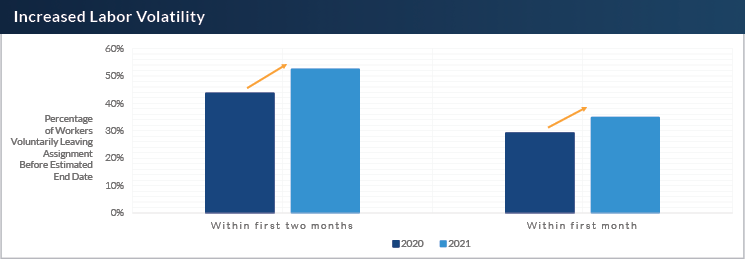First 30 Days Is Critical for Contingent Worker Retention
Magnit June 10 2022

In today’s volatile market, voluntary terminations remain high, and time to fill has also steadily climbed upward, underscoring a heightened difficulty in locating and landing quality candidates. With the hiring landscape so competitive and the cost of onboarding new workers remaining high, many organizations are searching for new worker retention strategies that can help them hold on to top-performing employees. But with job openings at high levels, how can organizations prevent quality workers from jumping ship?
In this blog post, we’ll dig into exclusive research from Magnit’s “Spring 2022 U.S. Labor Market Report” to reveal some key strategies organizations can employ to improve worker retention, including engaging new workers sooner after they start and incorporating discussion of personal development within these conversations.
Contingent Workers are Increasingly Leaving Jobs Earlier in the Assignment
Workers who voluntary terminate assignments before the scheduled end date are increasingly leaving their jobs earlier in the assignment. Of those professionals who leave before their scheduled end date, roughly one in two leaves within the first two months, and one in three leaves within the first month.
These results are up from 2020, where 44% of workers left within the first two months of assignment and only 29% of workers left within the first month of assignment.

The increase marks a rise in labor volatility, wherein workers are less willing to “stick it out” on a job and more likely to receive alternative offers from other companies.
Addressing Contingent Worker Retention Within First 30 Days
Given recruiting costs and steady market competition, employers should emphasize communication and retention immediately after assignment start, rather than targeting later timeframes when many workers will have already left and remaining workers are already likely to stay. Although 90-day reviews are common across many industries, the data indicates this timeframe falls when the risk of voluntary termination has already decreased substantially to about 10% for manufacturing roles and 8% for all other roles.
With this in mind, organizations should consider targeting the first 30 days of assignment for increased communication and more frequent informal reviews. Although many workers may leave a job due to skill mismatch or misaligned expectations, initial conversations can reset expectations or potentially explore alternative opportunities across the company. Increased communication and touch points early in an assignment can reduce overall turnover and ensure skills remain within the organization rather than back on the market.
Understanding What’s Important to Contingent Workers
Many organizations emphasize benefits and full-time employment conversion opportunities when looking to improve contingent worker retention. While these strategies are sound, Magnit’s research indicates that the top reasons people stay with an organization are unique project opportunities and/or the chance to develop new skills.
With that in mind, we recommend organizations emphasize these professional development opportunities not only in the market when recruiting, but also during discussions with new hires during the first 30 days. Companies should engage with new workers to understand what they’re interested in, discuss any project opportunities that might be relevant to them, and help them develop the skills they want to acquire. By broaching these key topics and doing so early on, organizations can help ensure they retain and integrate the new talent they’ve worked so hard to source.
For additional contingent worker retention strategies, plus more exclusive data and insights on effectively sourcing and managing today’s workforce, check out Magnit’s “Spring ’22 U.S. Labor Market Report.”
If you’re interested in learning more about how Magnit is helping organizations implement winning contingent workforce programs globally, please contact a Magnit representative at info@magnitglobal.com.
Disclaimer: The content in this blog post is for informational purposes only and cannot be construed as specific legal advice or as a substitute for legal advice. The blog post reflects the opinion of Magnit and is not to be construed as legal solutions and positions. Contact an attorney for specific advice and guidance for specific issues or questions.
